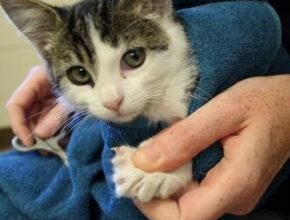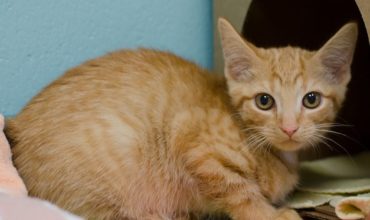[print-me] Vocalizing is one way for your cat to communicate with you and with other animals. Some cats “talk” more than others, but most cats do make noise some of the time. We’re all familiar with the meaning of hissing and growling, but there are also many other sounds that your cat is capable of, and a variety of reasons for vocalizing. Medical Reasons If your cat’s behavior changes suddenly, the first thing you should do is take her to your veterinarian for a thorough health examination. Cats often hide symptoms of illness until they’re seriously ill. Any change in
Read More
Archives for Kitten or cat
Trimming Cat Claws
[print-me] The act of trimming your cat’s nails can seem like a daunting task, but there is good news: A team of people working with a cat can get a nail trim done in 20 seconds flat. A little trickier is doing this alone, but rest assured, it can be done! Unfortunately, there is also bad news: Many cats are not tolerant of nail trims, and many people are not skilled in the process. Below are some pointers that will hopefully help cat owners keep their cats’ nails trimmed. 1. Know those nails! Most cats have 18 nails (five on
Read More
Declawing Cats
[print-me] Adapted from the MSPCA and revised by the ASPCA’s Companion Animal Services Department The American Society for the Prevention of Cruelty to Animals encourages owners to seek alternatives to declawing their cats. If you are thinking about having your pet declawed, please take a moment to consider the following information. Claws Are Important to a Cat A cat’s remarkable grace and agility and its faultless sense of balance are due to a great extent to its retractable claws, which allow it to establish footing for walking, running, springing, climbing, or stretching. A cat’s claws are also its best defense
Read More
How to Transition Your Cat to an Indoor/Outdoor Lifestyle
How to Transition Your Cat to an Indoor/Outdoor Lifestyle Want to give your cat some fun in the great outdoors? A slow start is key! Every cat is different; this could take from two weeks to a month or more. It’s important that your cat become acclimated to their indoor home, first. So please make sure kitty has a good amount of time inside with his family before beginning the process to acclimate them to indoor/ outdoor living. When your cat is feeling confident and calm in their indoor environment, they’ll be much more confident in their new indoor/ outdoor
Read More
Training Cats with Positive Reinforcement
[print-me] Training your cat has important benefits. You’re stimulating his body and his mind, which helps keep him healthy. And spending time together means you’re strengthening the bond you share. It’s helpful to work with behaviors that are less than desirable and you can also teach fun tricks like wave and fetch, or teach him a range of useful behaviors like sit, stay and to come when called. Reward behaviors that you want Simply put, if you want your cat to repeat a behavior, reward that behavior. It’s important to make sure that you’re rewarding the behavior you want and
Read More
Adopting a Fearful Cat
[print-me] Why Are Some Cats Fearful? Fearful behavior in cats can be caused by various factors. Insufficient exposure to humans and/or a variety of stimuli during kitten hood as well as traumatizing events in their lives can teach them to react fearfully towards people or new situations. Cats can also be genetically predisposed to being fearful. How to Introduce a Fearful Cat to a New Home Fearful cats usually do best in relatively quiet homes. They are often not suitable for young children as children can easily scare them with loud noises or sudden movements. Many fearful cats slowly become
Read More
Petting-Induced or Overstimulation Aggression in Cats
[print-me] Many of us have had the pleasure of petting our cat, when all of a sudden; the cat bites your hand and runs away. This is called petting induced or overstimulation aggression. It’s a common behavior in many cats, and is something that can be both frustrating and frightening until you learn how to manage this behavior with your cat. What causes this behavior? Cats are normally not as social as dogs, nor do they have as much physical contact with others of their species. They may groom each other and sleep close to each other, but have few
Read More
Adopting a Fearful Kitten
[print-me] What Does “Fearful” Mean? A fearful kitten is generally one that has not had full socialization. If a kitten does not have much contact with people when it is between the ages of 3 weeks and 7 weeks, it is likely to be scared of strangers it meets. Depending on the individual temperament of the kitten, what it has observed from its mother, and how old it is, it may hiss, spit or strike out – or may simply attempt to run away. Some fearful kittens learn to trust people quickly, others can take a long time. This depends
Read More
Keeping Cats off of Countertops
[print-me] Why Do Cats Like to Climb? Cats climb for several reasons. They seek out high vantage points, like countertops and shelves, to survey their territory. They can leap onto bookshelves or scale curtains to escape from another household pet or from something that scares them. Tables and the top of the refrigerator often provide warm, sunny places to snooze. Cats can learn to patrol or “surf” countertops, stovetops and tables in search of tasty tidbits left behind. Alternatives to Climbing on Countertops and Tables It’s best not to stifle your cat’s normal jumping and climbing behavior. Your cat will
Read More
Introducing Cats to Children
[print-me] Cats are the most prevalent family pet in the United States and it’s no wonder. They’re quiet and easy to care for—a perfect match for busy families with kids. Raising children with pets provides many benefits. According to the American Academy of Child & Adolescent Psychiatry, pets can: Teach empathy and compassion Provide love, loyalty and affection Foster self esteem Promote physical activity Teach responsibility Provide valuable life lessons Provide a connection to nature What cat lover wouldn’t want to share these wonderful values with their children? Children are naturally drawn to cats, but it’s important to lay some
Read More













